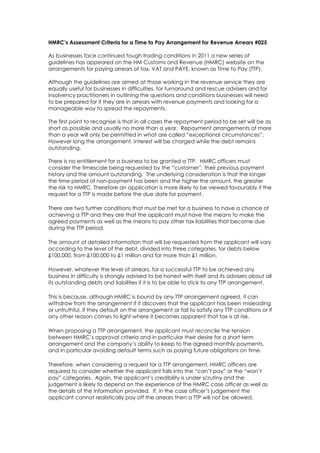Hmrc's assessment criteria for a time to pay arrangement for revenue arrears #025
•
0 likes•245 views
Report
Share
Report
Share
Download to read offline

Recommended
Recommended
More Related Content
Featured
Featured (20)
How Race, Age and Gender Shape Attitudes Towards Mental Health

How Race, Age and Gender Shape Attitudes Towards Mental Health
AI Trends in Creative Operations 2024 by Artwork Flow.pdf

AI Trends in Creative Operations 2024 by Artwork Flow.pdf
Content Methodology: A Best Practices Report (Webinar)

Content Methodology: A Best Practices Report (Webinar)
How to Prepare For a Successful Job Search for 2024

How to Prepare For a Successful Job Search for 2024
Social Media Marketing Trends 2024 // The Global Indie Insights

Social Media Marketing Trends 2024 // The Global Indie Insights
Trends In Paid Search: Navigating The Digital Landscape In 2024

Trends In Paid Search: Navigating The Digital Landscape In 2024
5 Public speaking tips from TED - Visualized summary

5 Public speaking tips from TED - Visualized summary
Google's Just Not That Into You: Understanding Core Updates & Search Intent

Google's Just Not That Into You: Understanding Core Updates & Search Intent
The six step guide to practical project management

The six step guide to practical project management
Beginners Guide to TikTok for Search - Rachel Pearson - We are Tilt __ Bright...

Beginners Guide to TikTok for Search - Rachel Pearson - We are Tilt __ Bright...
Unlocking the Power of ChatGPT and AI in Testing - A Real-World Look, present...

Unlocking the Power of ChatGPT and AI in Testing - A Real-World Look, present...
Hmrc's assessment criteria for a time to pay arrangement for revenue arrears #025
- 1. HMRC’s Assessment Criteria for a Time to Pay Arrangement for Revenue Arrears #025 As businesses face continued tough trading conditions in 2011 a new series of guidelines has appeared on the HM Customs and Revenue (HMRC) website on the arrangements for paying arrears of tax, VAT and PAYE, known as Time to Pay (TTP). Although the guidelines are aimed at those working in the revenue service they are equally useful for businesses in difficulties, for turnaround and rescue advisers and for insolvency practitioners in outlining the questions and conditions businesses will need to be prepared for if they are in arrears with revenue payments and looking for a manageable way to spread the repayments. The first point to recognise is that in all cases the repayment period to be set will be as short as possible and usually no more than a year. Repayment arrangements of more than a year will only be permitted in what are called “exceptional circumstances”. However long the arrangement, interest will be charged while the debt remains outstanding. There is no entitlement for a business to be granted a TTP. HMRC officers must consider the timescale being requested by the “customer”, their previous payment history and the amount outstanding. The underlying consideration is that the longer the time period of non-payment has been and the higher the amount, the greater the risk to HMRC. Therefore an application is more likely to be viewed favourably if the request for a TTP is made before the due date for payment. There are two further conditions that must be met for a business to have a chance of achieving a TTP and they are that the applicant must have the means to make the agreed payments as well as the means to pay other tax liabilities that become due during the TTP period. The amount of detailed information that will be requested from the applicant will vary according to the level of the debt, divided into three categories, for debts below £100,000, from £100,000 to £1 million and for more than £1 million. However, whatever the level of arrears, for a successful TTP to be achieved any business in difficulty is strongly advised to be honest with itself and its advisers about all its outstanding debts and liabilities if it is to be able to stick to any TTP arrangement. This is because, although HMRC is bound by any TTP arrangement agreed, it can withdraw from the arrangement if it discovers that the applicant has been misleading or untruthful, if they default on the arrangement or fail to satisfy any TTP conditions or if any other reason comes to light where it becomes apparent that tax is at risk. When proposing a TTP arrangement, the applicant must reconcile the tension between HMRC’s approval criteria and in particular their desire for a short term arrangement and the company’s ability to keep to the agreed monthly payments, and in particular avoiding default terms such as paying future obligations on time. Therefore, when considering a request for a TTP arrangement, HMRC officers are required to consider whether the applicant falls into the “can’t pay” or the “won’t pay” categories. Again, the applicant’s credibility is under scrutiny and the judgement is likely to depend on the experience of the HMRC case officer as well as the details of the information provided. If, in the case officer’s judgement the applicant cannot realistically pay off the arrears then a TTP will not be allowed.
- 2. Finally, the guidelines make it clear that the preferred method of dealing with TTP requests is by telephone, because it allows for detailed questioning of the viability of the business, and therefore whether the proposed TTP will have a chance of succeeding, as part of the assessment of whether the situation is a “can’t” or a “won’t” pay. It is crucial, therefore, that before the telephone conversation that applicant has all the required information on income and expenditure prepared and ready with the help of a rescue adviser or insolvency practitioner so that they can remain calm throughout what can be a stressful situation.